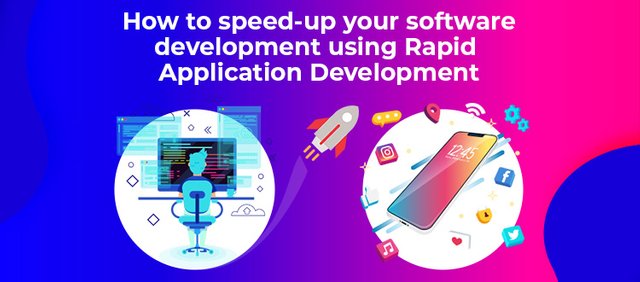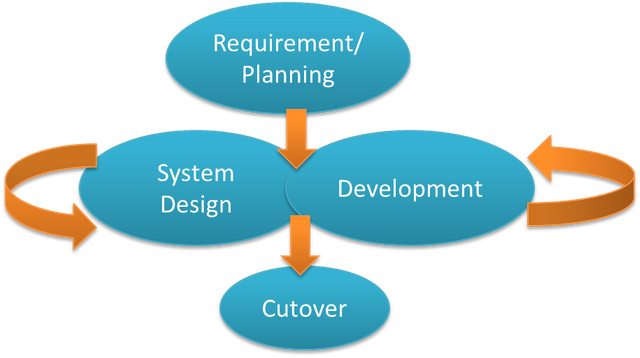How to Speed-up your Software Development Using Rapid Application Development

What if you are building a house for yourself and halfway through you realize that you have to make a major change in the structural design of the house? That will be pure chaos. The same applies to development in any field including software.
Thanks to Rapid Application Development, you don’t have to worry anymore about specific planning or changed requirements. Rapid Application Development or RAD is a software development model based on prototyping and iterative model. RAD approach to software development is against the waterfall software design approach which requires specific planning.
The biggest pain area for a PHP development company when following waterfall software design approach is that too often by the time software is ready for shipment, it is either out of date or becomes inefficient. In a traditional method of software project management, the team sticks to strict planning, process, and documentation. RAD approach does not follow this method. Rapid Application Development is similar Agile approach to software development. In an interesting study by PwC, it was found that Agile projects are 28% more successful than the waterfall approach.
Rapid Application Development addresses these issues by making use of predefined prototyping techniques and tools to develop software applications. It comprises a graphical user interface (GUI) development environment that facilitates the developer to build applications by dragging and dropping required software application components.
However, RAD’s working software prototypes or models lack the full functionality of a software application. The main objective of RAD is to develop prototypes for demonstration and requirement gathering. Rapid Application Development comes with built-in and customizable data, processes and organizational models. This allows for faster prototype development. It makes use of model-driven and object-oriented approach to develop a complete solution.
Introduction to Rapid Application Development
Rapid Application Development or RAD is an agile software development model. The biggest benefit it delivers is the fast project turnaround whereby the entire team works in a fast-paced environment. In the RAD approach, the entire team focuses on minimizing the time spent on planning and maximizing the focus on prototype development. This approach allows the project managers and stakeholders to accurately gauge progress and communicate in real time on issues and changes. This leads to greater efficiency, effective communication, and thereby aid faster development.
Rapid Application Development was invented in the 1980s to overcome the drawbacks of regressive traditional development models like Waterfall Software Development Model. The biggest issue with Waterfall Software Development Model is that once the software enters the testing phase it becomes extremely difficult to change its core functions and features. You may end up with the product that may not fit your evolving requirements.
RAD is a progressive development model that emphasizes on rapid prototyping and speedy feedback. This significantly cuts down the lengthy development time and testing cycle. Being a progressive development model, RAD allows software developers to make multiple iterations quickly without the need to restart a development schedule from scratch again. RAD has gained much popularity and acceptance in development communities and business because it helps them stay relevant in today’s competitive marketplace where technology is changing at a much faster speed than ever.
The 4 Phases of the RAD Model

A PHP web development company builds a prototype using Rapid Application Development. Then the client has to provide feedback for the prototype developed. The PHP website development services company again makes changes to the prototype based on feedback, before delivering it back to the client. The process keeps repeating itself until the client validates the prototype. PHP web development company along with client finalize the SRS (software requirement specification) and product designs. There are four phases of the RAD model:
1. Defining requirements
2. Developing prototype
3. Feedback and client validation
4. Finalize software
1. Defining Requirements
Rapid Application Development takes a very different approach to define development requirements. Instead of spending endless hours collecting the detailed list of specifications, RAD requires just a broad requirement to start. Since the requirement is broad, there is scope to collect specific requirement at different points of the development cycle. This way, RAD is better positioned to handle the changed requirement and is more flexible in its approach. At the initial stage the development team, the design team, and the end users come on a rough agreement over the project scope and application requirements. One of the key features of rapid application development is permission to change requirements at any point in the development cycle. Here is a breakdown of the stages involved:
- Researching the current problems
- Defining the requirements
- Finalizing the requirements with the stakeholders
It is important to get the approval of all the stakeholders involved to make sure the goals and expectations for the project are set right. This will also help everyone stay on the same page. This is especially more relevant when you Hire PHP Developer or have new members on the team.
2. Developing Prototype
In the rapid application development phase, the main goal of the development team is to quickly build something to show to the client. Rather than following a strict set of requirements, the development teams focus their energy and time developing prototypes with different features and functions as fast as they can. The prototype is sent to the client who decides what they like and what they don’t. The basic goal is to quickly prepare a working prototype with limited functionality to show off certain features to the client. The prototypes are in working conditions but they may not be properly polished. That's because the product is polished and finetuned during its final stage, once the client had approved the working prototypes.
3. Feedback and Client Validation
At this stage, the client provides the feedback of the product. The client feedback talks about functionality and visual aspect of the interface. This is also the time when product requirement is re-visited and changes are made if the client feels the need. Usually, during this time the client may change their mind on a few things. Probably something that seemed right on paper initially, may not appear a good idea on a prototype. With the feedback in hand, the developers go back to developing the prototype again. Only when the development team receives positive feedback from the client and the prototype satisfies the client, that developers move to the next step (finalizing the software).
4. Finalize Software
At this stage, the development team may re-engineer their implementation or optimize the product for improved stability and maintainability. The development team also spend their time connecting the back-end to production data and carry other maintenance tasks required before finally handing the product over to the client with confidence. In this phase, the development team along with the client finalizes features, functions, aesthetics, and the interface of the software
Advantages of Rapid Application Development
RAD is one of the most successful software development methods. It offers a number of benefits to both the client and the software development company. Here is a small list of advantages of Rapid Application Development:
1. Speed - In a RAD approach, the product is likely to finish on time and to the client’s satisfaction. However, this is not the case with the traditional waterfall approach. A lot of things change from the time the project was first started. Many features may lose their relevance over time. Therefore the traditional waterfall approach will take more time to deliver the product to the client’s satisfaction.
2. Cost - Since the developers build the application to the client exact requirement, nothing more and nothing less, it takes lesser completion time. But in a traditional waterfall approach, the client may want to do away with many features that they no more want. There is no way to recover the cost of time spent on building such features.
3. Developer satisfaction - In a traditional waterfall approach the developer usually works in silos devoid of feedback or positive affirmation for a product well-made. At the end of the product development, the client requirements would have changed, technologies would have evolved. As a result, the client may not be fully satisfied with the end product even if it is built in strict accordance with the initial specification. But in a RAD approach, the client is involved at every stage of the development cycle. The developer receives constructive feedback throughout the development cycle. This gives them enough time to adapt to the changing development requirement and the client is most likely to be pleased with the end result.
Conclusion
RAD has become a popular methodology to quickly produce minimally-coded software applications and uses various tools and techniques. The main strength of RAD is in its ability to quickly produce a prototype. It creates predefined components, structures, and methods to quickly develop software models.
Given the volatile market conditions and the competitive marketplace, Rapid Application Development has become a necessity. RAD fuels low-code rapid application development which enables companies to roll-out new applications faster. Even though RAD development model came into existence in the 1980s, it is still relevant today.
I don't want to impose my opinion on you, but I can only advise you to read more about Ruby development outsourcing. I myself just recently found out about a custom software development service called UranCompany. It's an international software vendor dedicated to creating and delivering custom business solutions.
Of course, I understand that developers have to make everything work in the frontend, but to do so... I found an interesting solution for me. With it, you can create, modify, store and execute decision logic models as a set of business rules in no time - all with ProcessMIX. This tool is great for companies that want to get into the game, but don't have the resources or expertise needed to create their own solution from scratch.
I wanted to share my experience accelerating software development with Rapid Application Development. I was recently looking into ways to improve our development process, and hiring Knockout.js developers from WireFuture was a game changer. Their team's experience hire knockoutjs developers combined with experience with Knockout.js significantly accelerated our project timeline. Fully integrating Knockout.js into our PHP applications has improved the user experience and functionality.
This article provides a comprehensive overview of the end of support for SAP Business Suite 7, highlighting the potential impact on businesses using this software. The insights offered shed light on the importance of upgrading to newer SAP solutions to ensure continued efficiency and security. The guidance provided in the article serves as a valuable resource for companies looking to navigate this transition smoothly and maintain their competitive edge in the digital landscape.